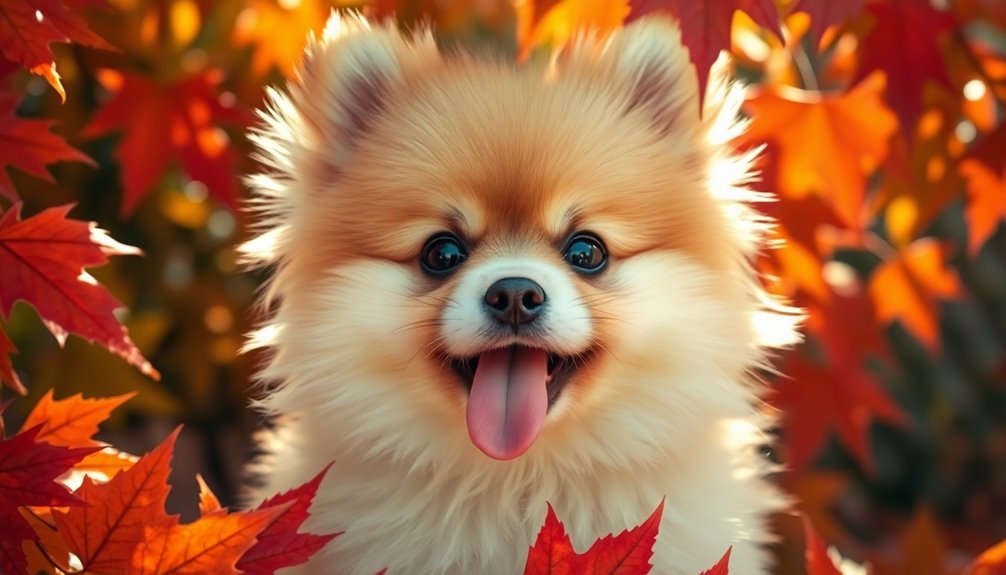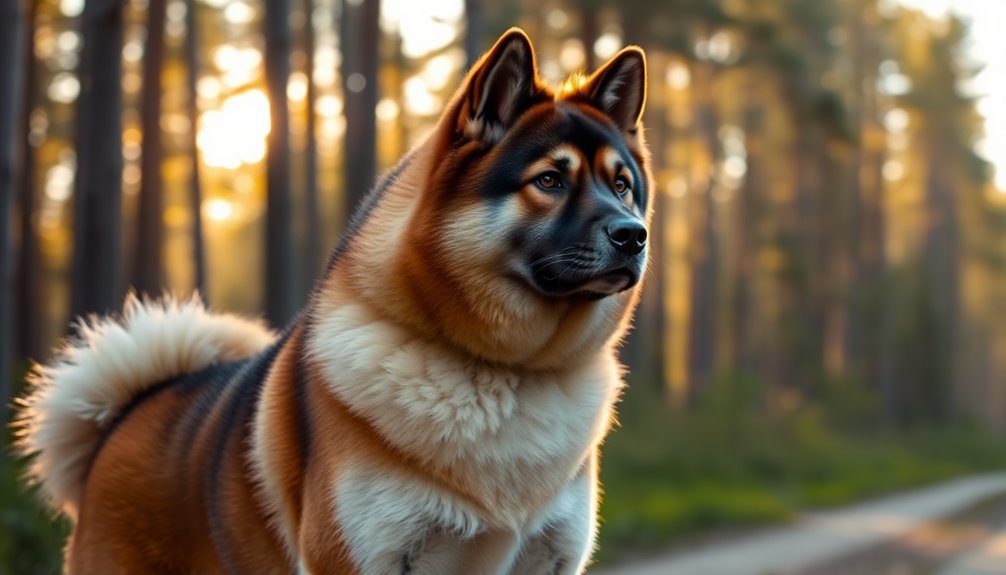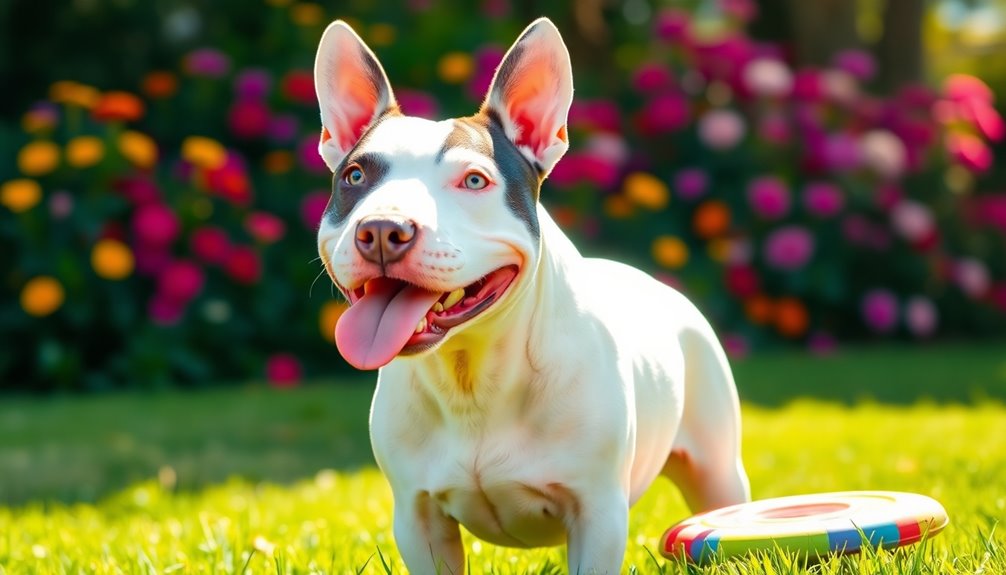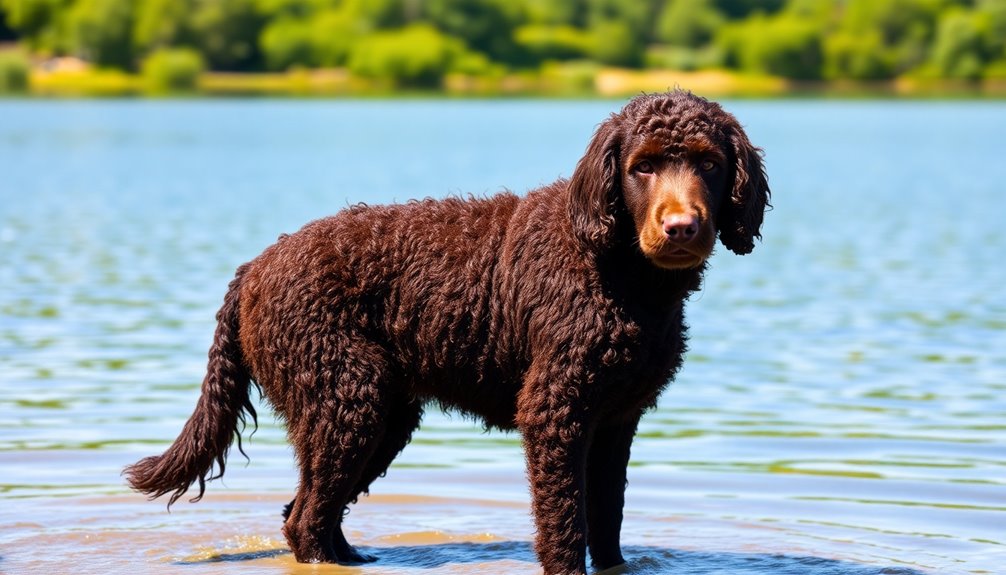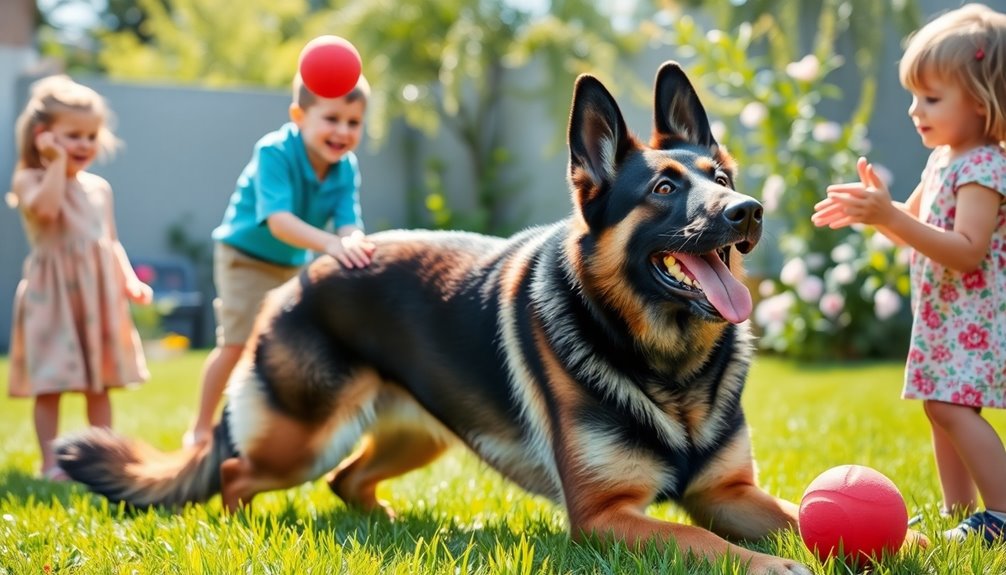You're going to love discovering Pomeranians! These lively pups originated from the Pomerania region and were bred down from larger Spitz dogs. Did you know they can actually give birth to twins? With over 25 color variations, each Pomeranian boasts its own unique charm. They've captured hearts throughout history, with famous owners like Mozart and even a survival story from the Titanic. Typically, Pomeranians live between 12 to 16 years. Their feisty personalities make training fun, but early socialization is key. Stick around to uncover more delightful facts about these charming companions!
Key Takeaways
- Pomeranians can give birth to twins, a rare occurrence in dogs, each with unique colors and appearances.
- Over 25 distinct color shades exist, including orange, black, cream, and lavender, showcasing their vibrant personalities.
- Pomeranians are known for their lively and extroverted nature, making them great companions for families and larger dogs.
- The breed's lifespan ranges from 12 to 16 years, with some living up to 21 years, emphasizing the importance of regular veterinary care.
- Famous figures like Mozart and modern celebrities such as Elvis Presley have owned Pomeranians, enhancing their cultural significance and popularity.
Origin of Pomeranians
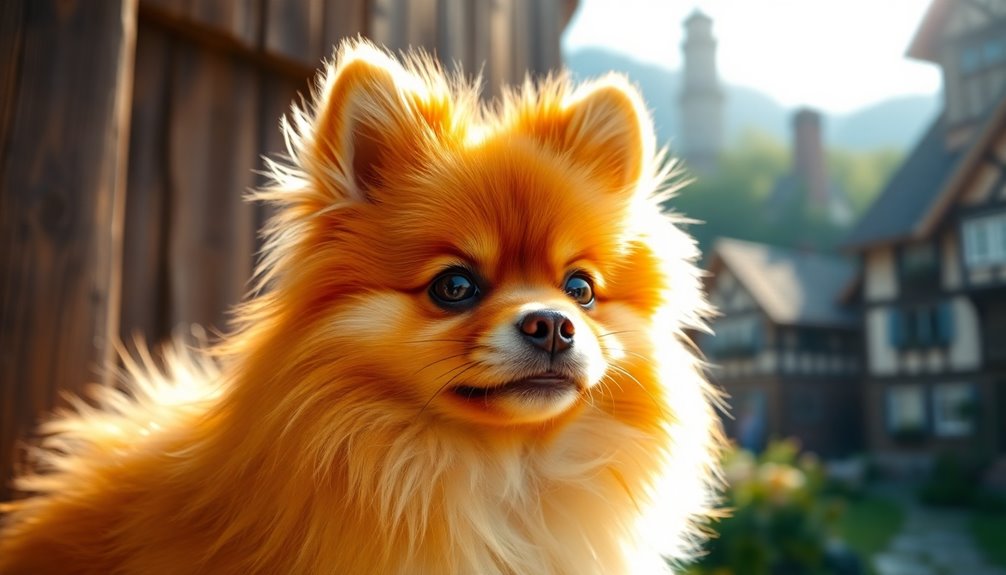
Pomeranians, known for their fluffy coats and lively personalities, trace their origins back to the Pomerania region in northern Germany and Poland.
These charming dogs are descendants of larger Spitz-type breeds, historically bred for herding, guarding livestock, and even pulling sleds in Arctic regions. Over time, Pomeranians transformed from robust working dogs into beloved companions, particularly as smaller versions gained popularity.
Their history took a significant turn in the 19th century when Queen Victoria owned a Pomeranian, sparking a trend for smaller breeds. This royal influence led to selective breeding, resulting in the toy breed we adore today. The size of Pomeranians has dramatically decreased by approximately 50% since then, making them one of the smallest members of the Spitz family.
With their resilient heritage, Pomeranians share traits with other Spitz breeds like Samoyeds, Huskies, and Akitas. Their lineage is a reflection of their adaptability and charm.
Plus, they even made headlines in 2016 with the first documented case of identical dog twins, showcasing a unique aspect of their reproductive traits. You can see how their fascinating history shapes the delightful companions they're today!
Size Changes Over Time
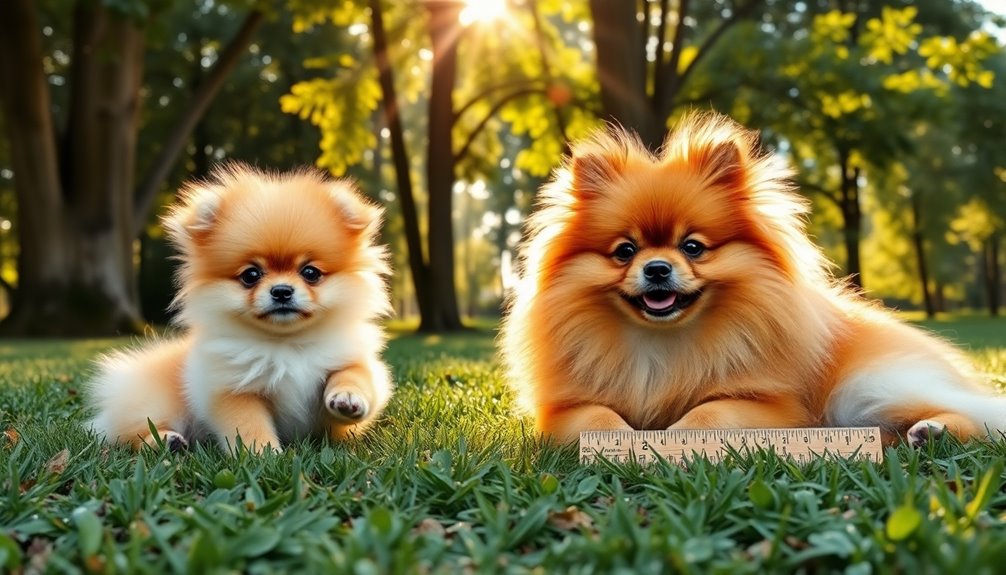
Over the years, the size of Pomeranians has changed dramatically, reflecting their evolution from robust working dogs to the petite companions we recognize today. Originally bred to weigh between 20 to 30 pounds for herding and guarding, the breed's size has been reduced by about 50% since the 19th century. This change was largely influenced by Queen Victoria's preference for smaller dogs, which set a trend that continues today.
Modern Pomeranians typically weigh between 3 to 7 pounds, making them one of the smallest dog breeds. However, this reduction in size has raised some concerns:
- Teacup Pomeranians can weigh under 3 pounds, leading to various health problems.
- The smaller size makes them highly portable, appealing to many dog lovers.
- Their affectionate nature enhances their popularity as companion animals.
- The breed's history as working dogs contrasts starkly with their current status as small lap dogs.
While these tiny Pomeranians make delightful pets, it's essential for you to take into account potential health risks associated with their size.
Always prioritize responsible breeding practices to guarantee a happy, healthy Pomeranian.
Famous Pomeranian Owners
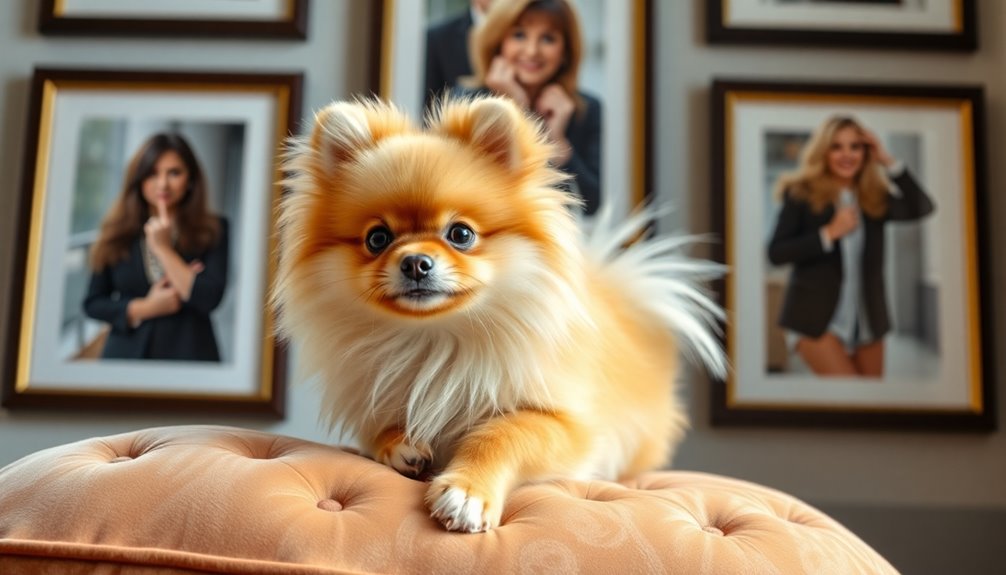
Many celebrities and historical figures have embraced the charm of Pomeranians, making them a beloved breed among the famous. You might be surprised to learn that renowned individuals like Martin Luther and Michelangelo once owned these delightful dogs, appreciating their companionship.
The Pomeranian breed's cultural significance even inspired composer Wolfgang Amadeus Mozart, who dedicated an aria to his beloved Pomeranian named Pimperl.
In modern times, celebrity ownership has played a massive role in popularizing Pomeranians. Icons like Elvis Presley, Sharon Osbourne, and Sylvester Stallone proudly showcase their furry friends, contributing to the breed's status as one of the most popular dog breeds.
Social media has further amplified this trend, with Boo, a Pomeranian boasting over 15 million Facebook followers, capturing hearts worldwide and starring in multiple picture books.
Let's not forget Jiffpom, another famous Pomeranian who holds two Guinness World Records for his incredible tricks. You might recognize him from Katy Perry's music video for "Dark Horse."
With such illustrious owners and accomplishments, it's no wonder that Pomeranians continue to capture the spotlight!
Pomeranians on the Titanic
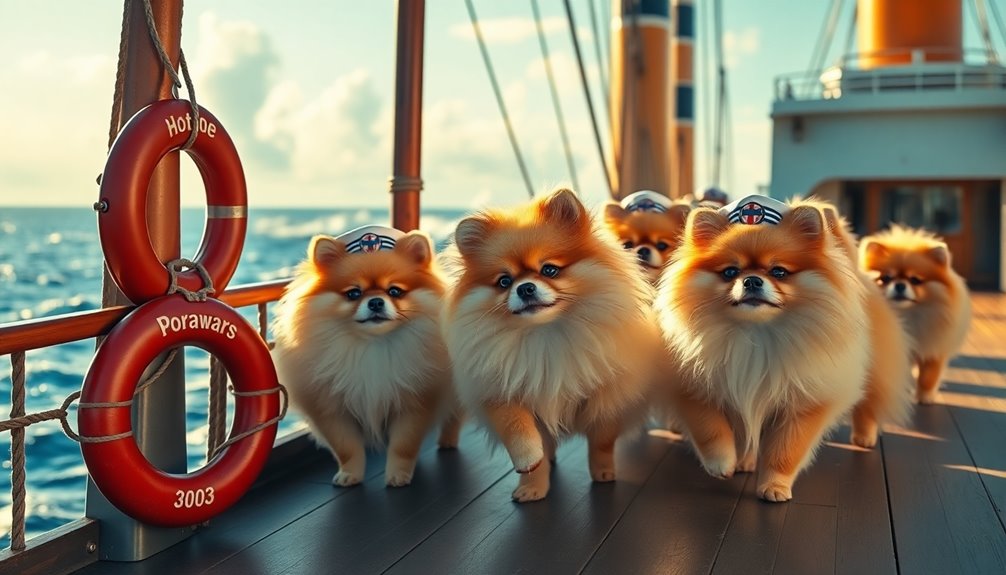
Have you ever wondered what happened to pets aboard the Titanic? Among the twelve dogs on board during that fateful journey in 1912, only three survived, including two Pomeranians. These beloved companions belonged to passengers Elizabeth Rothschild and Margaret Bechstein Hays, who refused to leave without their furry friends.
Here are some fascinating details about the Pomeranian dog breed's involvement in the Titanic's story:
- Rothschild wrapped her Pomeranian in a fur coat for protection during the evacuation.
- The two surviving Pomeranians played a significant role in increasing the breed's notoriety.
- Their survival story is often highlighted in discussions about the Titanic disaster.
- This incident showcases the deep bond between owners and their pets, even in dire situations.
The tenacity of Rothschild and Hays to save their Pomeranians not only reflects their love but also underscores how these dogs were seen as cherished family members.
The Titanic tragedy serves as a poignant reminder of the resilience of the human-animal bond, showcasing just how much these little Pomeranians meant to their owners amidst the chaos of that night.
Unique Birth Phenomenon
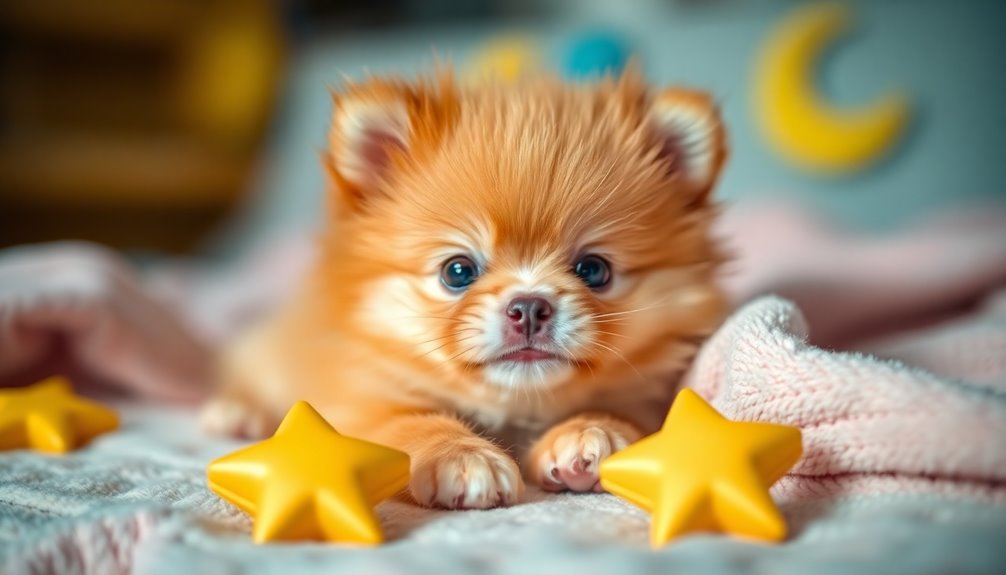
Did you know Pomeranians can give birth to twins, which is quite rare in the dog world?
Each puppy has its own sac but shares an umbilical cord, creating a unique dynamic in their litters.
This fascinating phenomenon not only showcases the breed's genetic diversity but also adds an interesting twist to Pomeranian reproduction.
Twin Birth Characteristics
In recent years, Pomeranians have captured the attention of dog lovers not just for their adorable looks but also for their intriguing reproductive traits, particularly twin births. This phenomenon is relatively unique within the canine world, as Pomeranians show a higher likelihood of delivering twins compared to other breeds.
Here are some fascinating characteristics of twin births in Pomeranians:
- Each puppy develops in its own embryonic sac but shares a single umbilical cord, which is uncommon among most dog breeds.
- The puppies from a twin birth are rarely identical; they can vary in color and appearance, adding to the breed's charm.
- This occurrence can lead to larger litters, affecting care requirements for the mother and her growing offspring.
- The reasons behind this unique phenomenon in Pomeranians remain unclear, making it an enthralling aspect of the breed's reproduction.
Understanding these twin birth characteristics can help you appreciate Pomeranians even more. Their ability to produce twins not only adds to their unique charm but also highlights the fascinating complexities of dog breeding.
Rarity Among Dog Breeds
Pomeranians stand out among dog breeds not just for their vibrant personalities and fluffy coats, but also for their rare reproductive traits. One fascinating aspect of this breed is their unique tendency to occasionally give birth to twin Pomeranian puppies. This rare occurrence in canine reproduction was first documented in 2016, highlighting the breed's charm and uniqueness.
In cases of twin births, each puppy has its own embryonic sac but shares a single umbilical cord. This leads to distinct puppies, which may even have different colors. While such twin births are uncommon, they can increase the number of puppies in a single litter, impacting the care requirements for both the mother and her offspring.
The reasons behind this twin birth phenomenon remain unclear, adding an element of mystery to the Pomeranian breed. As you explore the world of Pomeranians, you'll find that their unusual reproductive traits not only make them stand out but also deepen your appreciation for this delightful breed of dog.
Unique Litter Dynamics
Experiencing the unique dynamics of Pomeranian litters can be a fascinating journey for dog enthusiasts. Pomeranians have a higher likelihood of twin births compared to other breeds, making this a rare phenomenon in canine reproduction. Each twin puppy typically has its own embryonic sac but shares one umbilical cord, leading to intriguing birth dynamics that set Pomeranians apart.
Here are some key points about Pomeranian twin births:
- Twin births may contribute to a larger overall puppy count in a Pomeranian litter.
- The first documented case of identical dog twins was recorded in 2016, highlighting this breed's extraordinary traits.
- Unique birth dynamics can impact the care requirements for both the mother and her puppies.
- This distinctive reproductive trait enhances the charm and appeal of Pomeranians among dog lovers.
Understanding these unique birth dynamics not only enriches your knowledge but also deepens your appreciation for Pomeranians. The combination of twin births and the breed's charismatic personality makes them a delightful addition to any family.
Color Variations in Pomeranians
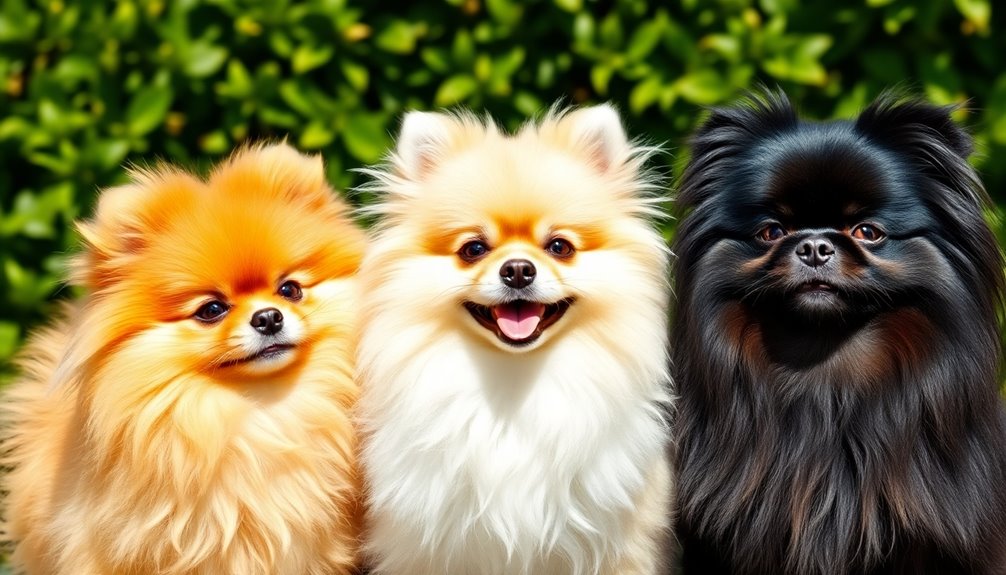
When it comes to Pomeranians, you'll find a stunning array of colors—over 25 shades, from orange to blue.
As your furry friend grows, don't be surprised if their coat changes; puppies often shift from cream to deeper hues.
These vibrant color variations, complete with unique markings, make each Pomeranian a true standout.
Diverse Color Palette
Have you ever noticed how many stunning colors Pomeranians come in? This breed boasts a diverse color palette that truly enhances their charm. With over 25 distinct colors, you'll find popular shades like:
- Orange
- Black
- Cream
- Lavender
But it doesn't stop there! Pomeranians also exhibit various color patterns, including parti-color, tri-color, brindle, mask, and sable. Each pattern adds to their unique visual appeal, allowing them to stand out in a crowd.
What's fascinating is that the coat colors can differ greatly from one Pomeranian to another, showcasing their individual personality. Some puppies may even change colors as they grow older; for instance, a creamy coat could darken to brown or white over time. This trait adds another layer of intrigue to the breed.
The diverse color palette is a big part of what makes Pomeranians so popular among dog lovers. Many breeders even specialize in specific colors to meet the high demand, ensuring you can find the perfect pup that captures your heart!
Age-Related Color Changes
Pomeranians aren't just charming in their diverse colors; they also undergo fascinating age-related color changes as they mature. As a Pomeranian owner, you might notice considerable color changes in your pup.
For instance, some puppies shift from cream to brown or even white hues over time. This phenomenon, often referred to as "puppy uglies," occurs when puppies lose their initial fur before developing their adult coats.
Typically, these color changes happen between the ages of four months to two years, revealing the dog's genetic makeup more clearly. The extent and nature of these changes are unpredictable; each dog is unique, leading to delightful surprises in their adult coats.
You may end up with a Pomeranian sporting unique color patterns that add to their individuality. Understanding these transformations can enhance your appreciation of the breed's charm.
The evolution of your Pomeranian's coat not only showcases their beauty but also contributes considerably to their overall appeal as pets. Embrace the journey of color changes, and enjoy watching your fluffy companion grow and evolve!
Temperament and Behavior Traits
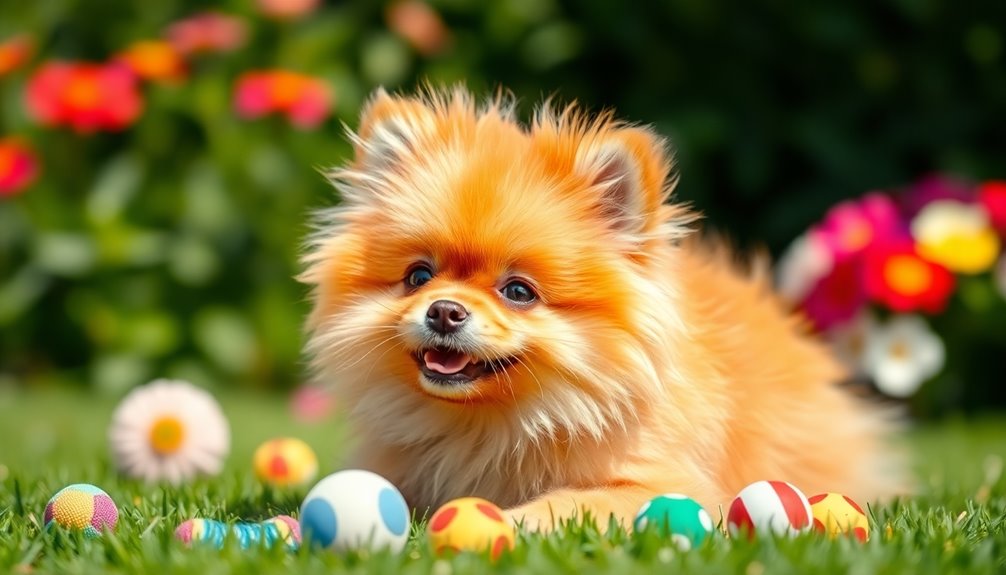
These little furballs are known for their lively and extroverted personalities, making them a joy to have around. Pomeranians, despite their small size, boast a bold attitude that often leads them to engage with larger dogs—sometimes with amusing results.
Their intelligence shines through during training sessions, but you might encounter some stubbornness along the way, so patience is key.
Social interaction is essential for your Pomeranian's happiness. They thrive on engaging with both humans and other pets, which makes them wonderful companions for families.
Here are some key temperament and behavior traits to keep in mind:
- Playful and Energetic: Pomeranians are always ready for fun, so be prepared for their playful antics.
- Vocal Nature: These dogs love to chat! Their barking can be frequent, requiring some management.
- Confident: Don't be surprised if your small Pomeranian boldly challenges larger dogs.
- Intelligent but Stubborn: While they learn quickly, be ready for some resistance during training.
Pomeranians in Arts and Culture
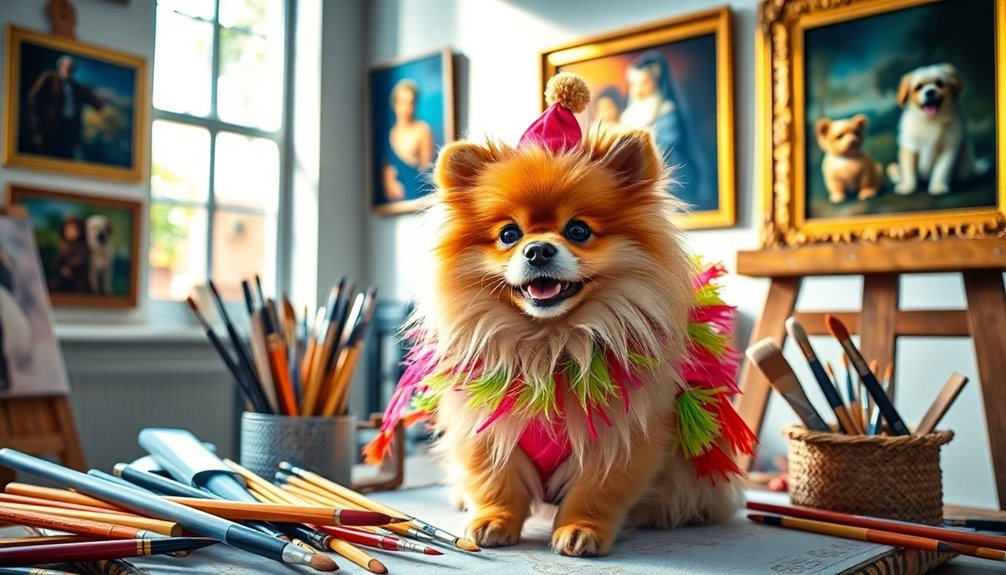
Pomeranians have made quite an impact in the world of arts and culture, inspiring historical figures like Mozart and Chopin.
You'll find these charming pups not only in the company of famous personalities but also in modern media, solidifying their place in pop culture.
Their influence stretches across centuries, showcasing their unique appeal and connection to creativity.
Historical Artistic Inspirations
Throughout history, Pomeranians have inspired countless artists and musicians, leaving an indelible mark on the cultural landscape. Their charm and fluffy appearance have captivated many, including notable historical figures who cherished these little companions.
For instance, Mozart dedicated an aria to his beloved Pomeranian, Pimperl, showcasing the breed's deep connection to musical artistry. Similarly, Chopin found inspiration for his famous "Waltz of the Little Dog" while sharing his creative space with a Pomeranian.
The breed also made its way into visual arts; Michelangelo kept a Pomeranian by his side while painting the Sistine Chapel, emphasizing the dog's presence in his creative process.
Pomeranians' cultural significance transcends time, appearing in various artistic expressions, such as:
- Musical compositions inspired by their playful nature
- Portraits depicting their regal stature
- Literature featuring their charming personalities
- Decorative arts celebrating their fluffy forms
These examples illustrate how Pomeranians haven't only enriched the lives of their owners but have also profoundly influenced the arts and culture throughout history. Their legacy continues, reminding us of their enduring appeal in creative circles.
Celebrity Connections and Ownership
Many historical figures haven't only admired Pomeranians but also formed lasting bonds with them, further solidifying their status in arts and culture. For instance, Mozart dedicated an aria to his beloved Pom, Pimperl, while Michelangelo had his Pom by his side as he painted the Sistine Chapel.
The breed really gained traction in England, thanks to Queen Victoria, who owned an impressive 35 Pomeranians. Her influence on breeding led to the smaller size that many adore today.
In pop culture, famous Pomeranians like Boo and Jiffpom have captured the hearts of millions. Boo has an astounding 15 million Facebook followers, while Jiffpom holds two Guinness World Records for his remarkable antics. Their fame contributes to the breed's appeal among celebrities and dog enthusiasts alike.
Pomeranians also leave their mark in the arts; composers like Chopin found inspiration in these lively pups, creating pieces such as "Waltz of the Little Dog."
With their connections to historical figures and their presence in pop culture, Pomeranians continue to charm and inspire both past and present.
Pomeranians in Modern Media
You'll often find Pomeranians making appearances in various forms of modern media, showcasing their charm and playful personalities.
These fluffy companions have captured the hearts of many and have become significant figures in pop culture. Celebrity Pomeranians like Boo and Jiffpom have risen to fame, proving just how much you can love these pint-sized pooches.
Consider these fun facts about Pomeranians in modern media:
- Boo has over 15 million Facebook followers and even released four picture books.
- Jiffpom starred in Katy Perry's music video for "Dark Horse," enhancing his celebrity status.
- Their influence isn't new; even Mozart and Chopin found inspiration in Pomeranians, dedicating pieces to them.
- Michelangelo's Pomeranian was present during the creation of the Sistine Chapel, marking their presence in historical art.
With their infectious energy and endearing looks, Pomeranians continue to thrive in modern media, capturing the affection of fans worldwide.
It's no wonder they're beloved icons, making appearances that keep you smiling!
Health and Lifespan Insights
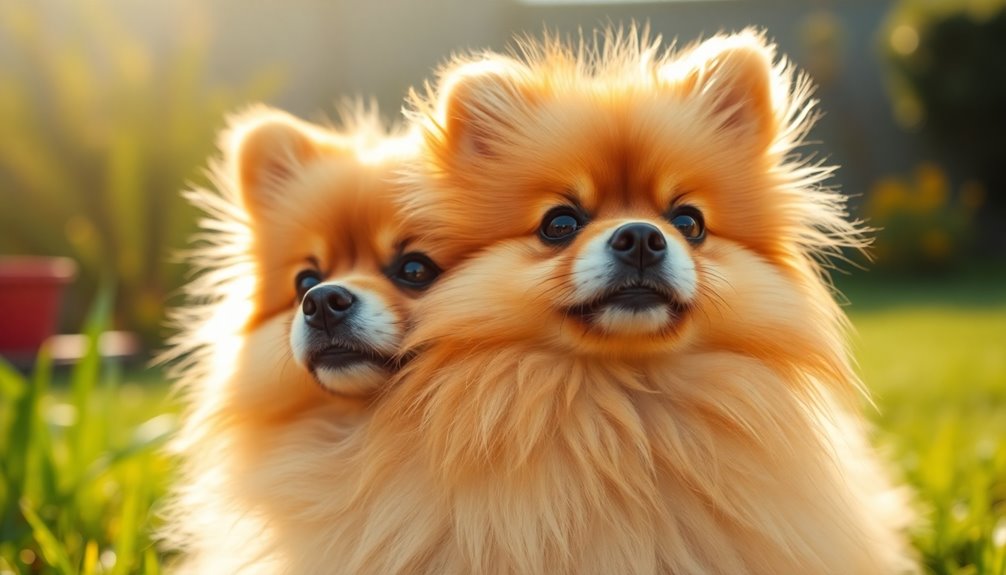
Pomeranians are adored for their lively personalities and fluffy coats, but understanding their health and lifespan is vital for any potential owner.
These charming little dogs typically live between 12 to 16 years, with some even reaching 21 years when given the best care. However, their small size makes them susceptible to specific health issues, including hypoglycemia, hip dysplasia, patellar luxation, and dental problems.
Regular veterinary check-ups are important for detecting and managing these health concerns early. By maintaining a healthy diet and a routine wellness plan, you can greatly enhance your Pomeranian's longevity and overall health.
Be cautious about where you get your Pomeranian; unethical breeding practices, especially with teacup variations, can lead to additional complications and health risks.
Monitoring your pup's condition closely and ensuring prompt treatment for any emerging health issues can improve their quality of life.
Training and Socialization Tips
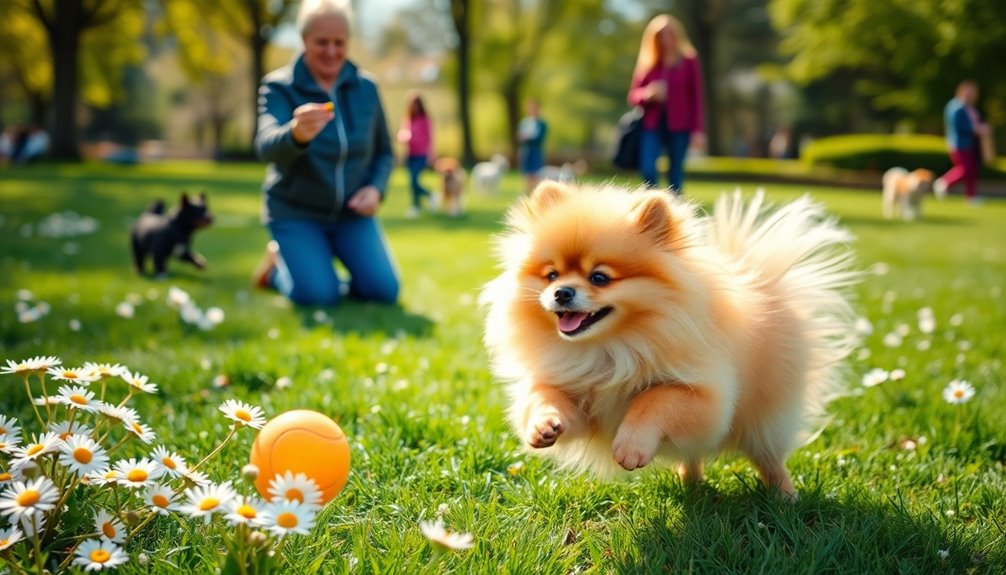
To help your Pomeranian thrive, effective training and socialization are essential. Start early with socialization to expose your pup to various people, environments, and experiences. This early foundation helps them develop into well-adjusted dogs.
Here are some tips to contemplate:
- Use positive reinforcement training methods, as Pomeranians respond well to treats and praise.
- Keep training sessions short and engaging to accommodate their short attention span.
- Attend obedience classes for structured socialization and skill enhancement.
- Maintain consistency in commands and routines to build understanding and strengthen your bond.
Frequently Asked Questions
What Is an Interesting Fact About Pomeranians?
An interesting fact about Pomeranians is their unique twin birth phenomenon. You might be surprised to learn that a female can give birth to twins, each with its own embryonic sac but sharing one umbilical cord.
This rarity among dog breeds showcases the fascinating aspects of Pomeranians. Plus, their bold personalities and vocal tendencies make them stand out even more, often challenging much larger dogs despite their small size.
Isn't that adorable?
What Do Pomeranians Love the Most?
Pomeranians love companionship the most. They thrive on social interaction, so including them in family activities is essential.
Their playful nature means they enjoy engaging with other dogs, making playdates a highlight. You'll find they also crave mental stimulation, often getting excited about puzzle toys or learning new tricks.
Regular walks and interactive games keep them active, while cozy cuddles in soft blankets provide the comfort they adore.
What Makes a Pomeranian Special?
What makes a Pomeranian special is their vibrant personality and unique appearance.
You'll notice their fluffy double coat and charming fox-like face that instantly captures attention.
They're confident and bold, often thinking they're much bigger than they really are.
Their intelligence shines through as they quickly learn tricks, but they can be a bit stubborn, too.
With their lively nature, they thrive on social interaction, making them delightful companions for you.
Why Do Pomeranians Kiss so Much?
Imagine coming home after a long day, and your Pomeranian rushes to greet you with enthusiastic kisses.
Pomeranians kiss so much because they express their affection and bond with you through this behavior. Their friendly nature, vocal tendencies, and protective instincts drive them to initiate kisses as a form of communication.
Plus, they're sensitive to your emotions, often offering comforting kisses during both stressful and joyful moments, making them incredibly loving companions.
Conclusion
To sum up, Pomeranians are more than just adorable fluffballs; they have a fascinating history and unique traits that make them special. Did you know that these little dogs can weigh as little as three pounds? Despite their small size, they pack a big personality and are known for their intelligence and loyalty. So, whether you're considering adding a Pomeranian to your family or just love learning about them, there's always something new to discover!

